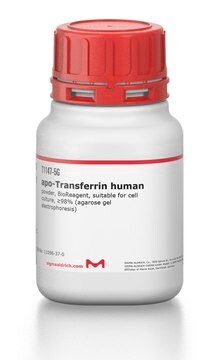About This Item
Produtos recomendados
fonte biológica
synthetic (organic)
Nível de qualidade
descrição
RGD Peptide for Cell Adhesion, 5 mg
esterilidade
electron beam irradiated
Ensaio
≥95% (HPLC)
Formulário
powder
técnica(s)
tissue culture: suitable
Condições de expedição
wet ice
temperatura de armazenamento
2-8°C
cadeia de caracteres SMILES
N1([C@@H](CCC1)C(=O)N[C@@H](C)C(=O)N[C@@H](CO)C(=O)N[C@@H](CO)C(=O)N[C@@H](CCCCN)C(=O)NCC(=O)NCC(=O)NCC(=O)NCC(=O)N[C@@H](CO)C(=O)N[C@@H](CCCN\C(=N\[H])\N)C(=O)N[C@@H](CC(C)C)C(=O)N[C@@H](CC(C)C)C(=O)N[C@@H](CC(C)C)C(=O)N[C@@H](CC(C)C)C(=O)N[C@@H](CC(C)C)
InChI
1S/C98H174N34O30/c1-48(2)31-60(84(151)120-56(79(100)146)22-17-27-107-96(101)102)124-86(153)62(33-50(5)6)126-88(155)64(35-52(9)10)128-89(156)65(36-53(11)12)127-87(154)63(34-51(7)8)125-85(152)61(32-49(3)4)123-83(150)59(24-19-29-109-98(105)106)122-91(158)67(44-133)119-76(142)42-113-73(139)39-111-72(138)38-112-74(140)40-114-82(149)58(21-15-16-26-99)121-92(159)69(46-135)130-93(160)68(45-134)129-80(147)54(13)116-94(161)71-25-20-30-132(71)95(162)70(47-136)131-90(157)66(37-78(144)145)118-77(143)43-115-81(148)57(23-18-28-108-97(103)104)117-75(141)41-110-55(14)137/h48-54,56-71,133-136H,15-47,99H2,1-14H3,(H2,100,146)(H,110,137)(H,111,138)(H,112,140)(H,113,139)(H,114,149)(H,115,148)(H,116,161)(H,117,141)(H,118,143)(H,119,142)(H,120,151)(H,121,159)(H,122,158)(H,123,150)(H,124,153)(H,125,152)(H,126,155)(H,127,154)(H,128,156)(H,129,147)(H,130,160)(H,131,157)(H,144,145)(H4,101,102,107)(H4,103,104,108)(H4,105,106,109)/t54-,56-,57-,58-,59-,60-,61-,62-,63-,64-,65-,66-,67-,68-,69-,70-,71-/m0/s1
chave InChI
DULMZMHLQQZGPY-ACFXXXONSA-N
Aplicação
Use these procedures as a guideline to determine the optimal coating conditions for the culture system of coice. To maintain sterility, perform all operations in a laminar flow hood. Two options are provided:
Procedure A
1. Remove cap and add 5 ml of serum-free medium or PBS to the bottle.
2. Replace cap and vortex contents vigorously. Ensure that the PEPTITE-2000 is completely solubilized. The solution will remain slightly hazy.
3. Transfer desired volume of solution from the bottle to a dilution vessel. Dilute to desired concentration using serum-free medium or PBS. A typical working concentration may range from 0.1 to 10 μg/ml.
4. Add appropriate amount of diluted material to culture surface.
5. Incubate at room temperature or 37 °C, covered, for 1-2 hours.
6. After incubation, aspirate remaining material.
7. Rinse plates carefully with water and avoid scratching bottom surface of plates.
8. Plates are ready for use. They may also be stored at 2-8 °C damp or air dried if sterility is maintained.
9. Store remaining solubilized PEPTITE-2000 at 2 to 10 °C.
Additional note: Include divalent cations (Calcium, Magnesium, or Manganese) in cell attachment solution to obtain optimum cell binding.
Procedure B
1. Remove cap and add 5 ml of sterile 70% Ethanol
2. Replace cap and vortex contents. Ensure that the PEPTITE-2000 is completely solubilized.
3. Transfer desired volume of solution from the bottle to a dilution vessel. Dilute to the desired concentration using 70% Ethanol. Concentrations from 0.1 to 10 μg/ml should be tested.
4. Add appropriate amount of diluted material to culture surface.
5. Leave the coated container, uncovered, in a laminar flow hood until the wells are dry.
6. Rinse plates carefully with water and avoid scratching bottom surface of plates.
7. Plates are ready for use.
8. Store remaining solubilized PEPTITE-2000 at 2-10 °C.
- paramagnetic beads prior to incorporation with embryonic stem cells
- Corning Transwell polycarbonate membrane inserts for promoting cell attachment
- tosyl-activated magnetic beads in human colonic epithelial cells (HT-29) for binding experiments
- gold nanorods
Características e benefícios
Outras notas
Qualidade
Informações legais
Código de classe de armazenamento
11 - Combustible Solids
Classe de risco de água (WGK)
WGK 3
Ponto de fulgor (°F)
Not applicable
Ponto de fulgor (°C)
Not applicable
Escolha uma das versões mais recentes:
Já possui este produto?
Encontre a documentação dos produtos que você adquiriu recentemente na biblioteca de documentos.
Nossa equipe de cientistas tem experiência em todas as áreas de pesquisa, incluindo Life Sciences, ciência de materiais, síntese química, cromatografia, química analítica e muitas outras.
Entre em contato com a assistência técnica







